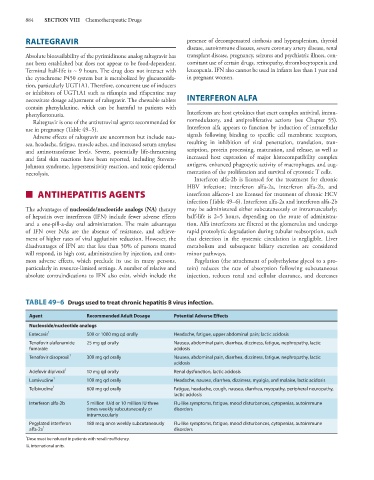Page 898 - Basic _ Clinical Pharmacology ( PDFDrive )
P. 898
884 SECTION VIII Chemotherapeutic Drugs
RALTEGRAVIR presence of decompensated cirrhosis and hypersplenism, thyroid
disease, autoimmune diseases, severe coronary artery disease, renal
Absolute bioavailability of the pyrimidinone analog raltegravir has transplant disease, pregnancy, seizures and psychiatric illness, con-
not been established but does not appear to be food-dependent. comitant use of certain drugs, retinopathy, thrombocytopenia and
Terminal half-life is ~ 9 hours. The drug does not interact with leucopenia. IFN also cannot be used in infants less than 1 year and
the cytochrome P450 system but is metabolized by glucuronida- in pregnant women.
tion, particularly UGT1A1. Therefore, concurrent use of inducers
or inhibitors of UGT1A1 such as rifampin and rifapentine may
necessitate dosage adjustment of raltegravir. The chewable tablets INTERFERON ALFA
contain phenylalanine, which can be harmful to patients with
phenylketonuria. Interferons are host cytokines that exert complex antiviral, immu-
Raltegravir is one of the antiretroviral agents recommended for nomodulatory, and antiproliferative actions (see Chapter 55).
use in pregnancy (Table 49–5). Interferon alfa appears to function by induction of intracellular
Adverse effects of raltegravir are uncommon but include nau- signals following binding to specific cell membrane receptors,
sea, headache, fatigue, muscle aches, and increased serum amylase resulting in inhibition of viral penetration, translation, tran-
and aminotransferase levels. Severe, potentially life-threatening scription, protein processing, maturation, and release, as well as
and fatal skin reactions have been reported, including Stevens- increased host expression of major histocompatibility complex
Johnson syndrome, hypersensitivity reaction, and toxic epidermal antigens, enhanced phagocytic activity of macrophages, and aug-
necrolysis. mentation of the proliferation and survival of cytotoxic T cells.
Interferon alfa-2b is licensed for the treatment for chronic
HBV infection; interferon alfa-2a, interferon alfa-2b, and
■ ANTIHEPATITIS AGENTS interferon alfacon-1 are licensed for treatment of chronic HCV
infection (Table 49–6). Interferon alfa-2a and interferon alfa-2b
The advantages of nucleoside/nucleotide analogs (NA) therapy may be administered either subcutaneously or intramuscularly;
of hepatitis over interferons (IFN) include fewer adverse effects half-life is 2–5 hours, depending on the route of administra-
and a one-pill-a-day oral administration. The main advantages tion. Alfa interferons are filtered at the glomerulus and undergo
of IFN over NAs are the absence of resistance, and achieve- rapid proteolytic degradation during tubular reabsorption, such
ment of higher rates of viral agglutinin reduction. However, the that detection in the systemic circulation is negligible. Liver
disadvantages of IFN are that less than 50% of persons treated metabolism and subsequent biliary excretion are considered
will respond, its high cost, administration by injection, and com- minor pathways.
mon adverse effects, which preclude its use in many persons, Pegylation (the attachment of polyethylene glycol to a pro-
particularly in resource-limited settings. A number of relative and tein) reduces the rate of absorption following subcutaneous
absolute contraindications to IFN also exist, which include the injection, reduces renal and cellular clearance, and decreases
TABLE 49–6 Drugs used to treat chronic hepatitis B virus infection.
Agent Recommended Adult Dosage Potential Adverse Effects
Nucleoside/nucleotide analogs
Entecavir 1 500 or 1000 mg qd orally Headache, fatigue, upper abdominal pain; lactic acidosis
Tenofovir alafenamide 25 mg qd orally Nausea, abdominal pain, diarrhea, dizziness, fatigue, nephropathy, lactic
fumarate acidosis
Tenofovir disoproxil 1 300 mg qd orally Nausea, abdominal pain, diarrhea, dizziness, fatigue, nephropathy, lactic
acidosis
Adefovir dipivoxil 1 10 mg qd orally Renal dysfunction, lactic acidosis
Lamivudine 1 100 mg qd orally Headache, nausea, diarrhea, dizziness, myalgia, and malaise, lactic acidosis
Telbivudine 1 600 mg qd orally Fatigue, headache, cough, nausea, diarrhea, myopathy, peripheral neuropathy,
lactic acidosis
Interferon alfa-2b 5 million IU/d or 10 million IU three Flu-like symptoms, fatigue, mood disturbances, cytopenias, autoimmune
times weekly subcutaneously or disorders
intramuscularly
Pegylated interferon 180 mcg once weekly subcutaneously Flu-like symptoms, fatigue, mood disturbances, cytopenias, autoimmune
alfa-2a 1 disorders
1
Dose must be reduced in patients with renal insufficiency.
IU, international units.

